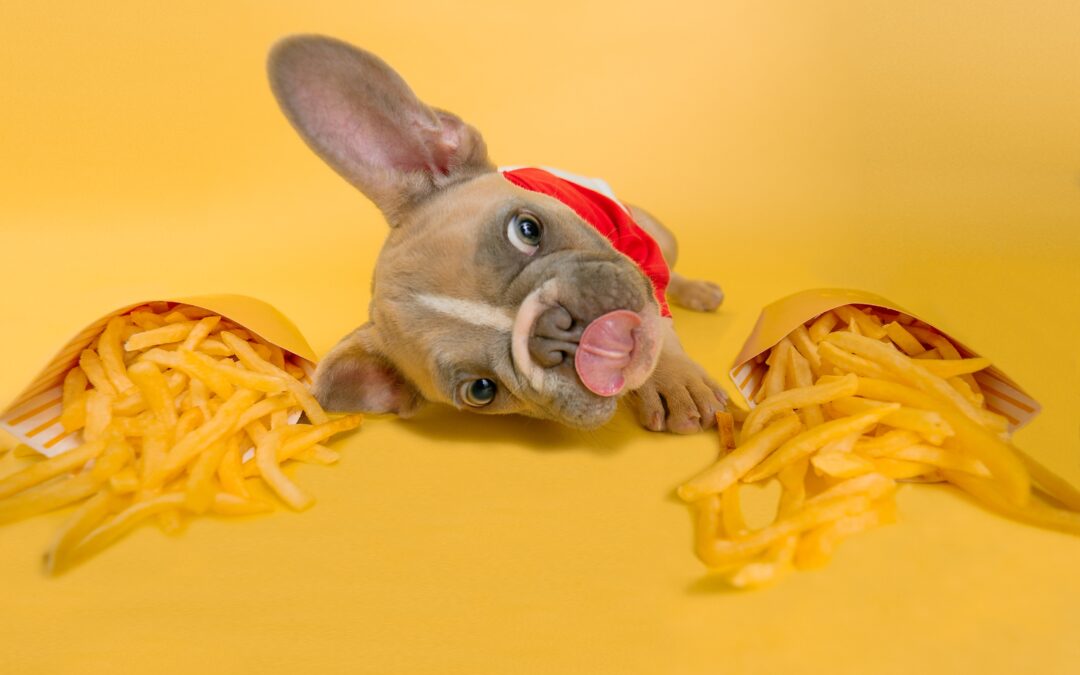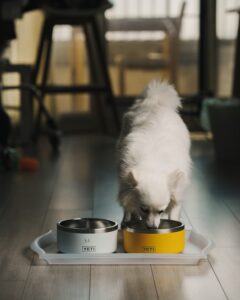Food aggression is a big topic of discussion here in the Northeast. Does your dog exhibit signs of protectiveness over their food, such as growling when you approach their bowl or snapping when you try to take away a bone? Join us as we explore some valuable pointers on how to deal with food aggression in dogs.
What is Food Aggression?
To begin with, what exactly is food aggression in dogs? Food-related aggression in canines refers to the display of aggressive behavior like growling, baring teeth, or biting, when a person or another animal approaches the dog while they are in possession of a food-related item like a bone, food bowl, treats, or even food that has fallen on the ground. Dogs exhibiting food aggression are more inclined to react negatively to items they perceive as delicious. Food aggression falls under the category of possessive aggression, which occurs when dogs exhibit aggressive behavior (like baring teeth, growling, or snapping) in relation to an item or object they consider valuable, such as food, toys, or a resting spot. Food aggression can be classified into three types:
- Moderate Food Aggression: Dog snaps or lunges when approached or touched by a person when in possession of or near food or a food related items.
- Mild Food Aggression: Dog shows their teeth or growls when approached or touched by a person when in possession of or near food or food related items.
- Severe Food Aggression: Dog bites when approached or touched by a person when in possession of or near food or food related items.
What Causes Food Aggression in Dogs?
There are numerous causes of food aggression in dogs. It does not indicate dominant behavior, but rather fear. In a canine pack, the alpha consumes food first and protecting their food is not about being dominant but is instead about defending their resource from others. A dog with mild food aggression may growl and bare their teeth. The next level of aggression involves snapping and lunging at anyone who comes near while eating. In severe cases, the dog may bite the “intruder”. When exhibiting food aggression, a dog keeps their head down, stiffens their body, raises their hackles, lowers their tail, and may show the whites of their eyes while guarding their food. Some dogs only show aggression at mealtime, while others display it towards all food sources, including bones, chew toys, and treats.
According to some behaviorists, dogs who demonstrate food aggression may be expressing reactions from their earliest experiences with food in their litter. During this time, the mother feeds all of her offspring simultaneously and the pups struggle to get their turn. As the pups grow up together, multiple individuals may be fed using the same bowl. Puppies who received less food or were forced to wait may develop a fear of having to compete for food. This fear can result in increased stress during mealtime and may cause the dog to view anyone who approaches them, even the person who provided the food, as a threat. A newer theory gaining traction among experts is that pet owners may be inadvertently creating an atmosphere that leads to their dog’s fear during mealtime.
One technique that is commonly used to train dogs by placing your hand in their food bowl while they eat or by removing their bowl mid-meal to establish dominance and make them get accustomed to your hands in their food, may have unintended negative consequences. Imagine dining at a restaurant where the server persistently lingers and frequently clears your plate before you finish. After experiencing this a few times, you may become inclined to hold onto your plate and express annoyance towards the server to leave you alone. From your dog’s perspective, you are like that bothersome server. There are other factors that can also contribute to your dog exhibiting food aggression, such as the kind of food you offer them. Food items that last a long time, like rawhide, can also cause an issue as they can become fixated on the item since it lingers around for a long period. Additionally, as your dog can carry around the food item, it can easily be moved or touched by someone else, which they may perceive as a threat. Feeding your dog in bustling areas where they can be bumped or sense others approaching them while they eat can also make them anxious and defensive over their food.
What Steps Should I Take?
There are many steps an owner can take to start the journey to fixing your dog’s food aggression problems. The first that we recommend is getting your dog into a training program with an experienced, professional trainer who specializes in behavioral modification and aggression training. When working with Off Leash K9 Training Northeast and our trainers throughout New York, New Hampshire, Massachusetts, Connecticut, and Vermont, we use a 5 part approach to this: Obedience, Confidence Building, Positive Association with People, Pack Leadership and Proper Correction for the Negative Behavior. We have found that this is a fundamental approach that is imperative to start working a dog towards rehabilitation, and all 5 components are necessary to be successful.
How Do We Fix the Food Aggression?
Firstly, we start by prioritizing obedience and developing confidence. To quote our owner and CEO Nick White, “You cannot fix any issue in a dog that doesn’t listen to you.” Overcoming control issues with your dog may seem daunting, but it is crucial in addressing any underlying problems. Through obedience training, you can assert your position as pack leader.
Secondly, establishing yourself as the pack leader is crucial for creating defined roles for both you and your dog. Just like with a pack of lions in the wild, the alpha males always eat first while the other members wait their turn. This doesn’t mean you should scare your dog, but rather make it clear to them who is in control. You can do this by not allowing your dog on furniture, eating before feeding your dog, walking through doors before them, and not allowing them to demand attention or table scraps. Your dog should be treated as the lowest member of the pack, not an equal. It is important to still provide them with proper care, attention, and exercise. By setting boundaries and making decisions, you establish yourself as the leader and maintain control.
Thirdly, begin placing your pet’s meals on the ground or a mat, not a bowl. This stops the dog from linking a specific item with protecting and safeguarding. Put out only a small number of food bits, roughly seven or eight, and wait for the dog to finish eating before adding more. Continue this routine until their entire meal is eaten. This is a small gesture that demonstrates to the dog that YOU manage their food.
Fourthly, the next step is to train your dog to sit or lie down while you prepare their food. This emphasizes the importance of obedience training for your dog. Once the food is placed on the floor or mat, wait for a brief moment before releasing them to eat. This exercise reinforces the idea that you have control over their feeding schedule.
Fifthly, you want to develop a favorable connection between yourself and your dog’s food. As your dog eats on the floor or mat, gradually move towards the feeding area from about 3-4 feet away (depending on how comfortable your dog is with its food). Toss some hot dogs or chicken (a high value reward) in their direction. When your dog becomes comfortable with your presence, try moving closer and throwing the rewards into their meal. Repeat this process until you can stand next to them and place the rewards in their food area or bowl. Essentially, this method teaches your dog to associate your proximity to their food with a positive experience, shifting their perception to “if someone approaches me or my food, it means something good for me.”
Sixthly, it is crucial to address negative behavior in your dog. To address this, it is recommended to enroll in an obedience program led by a reputable and qualified trainer who can guide you in properly correcting and modifying these aggressive tendencies. When your dog displays negative behavior such as growling, snapping, or snarling, it is important to implement correction just like an alpha lion would correct lower members of their pride. By informing your dog of the consequences of exhibiting food aggression and providing positive reinforcement when these behaviors are absent, they will learn the appropriate behavior to exhibit.
In summary, implementing these six steps can greatly assist in curbing food aggression in your dog. If you are in need of help, feel free to contact us for a no-cost phone consultation with one of our skilled trainers, who have experience tackling various types of dog behaviors, ranging from anxiety to subtypes of aggression. Our trainers are located throughout the northeast in New York State, New York City, Vermont, New Hampshire, Massachusetts, and Connecticut. We’re ready to help you achieve a training journey that will result in a life free of aggression. Your dog will thank you!




